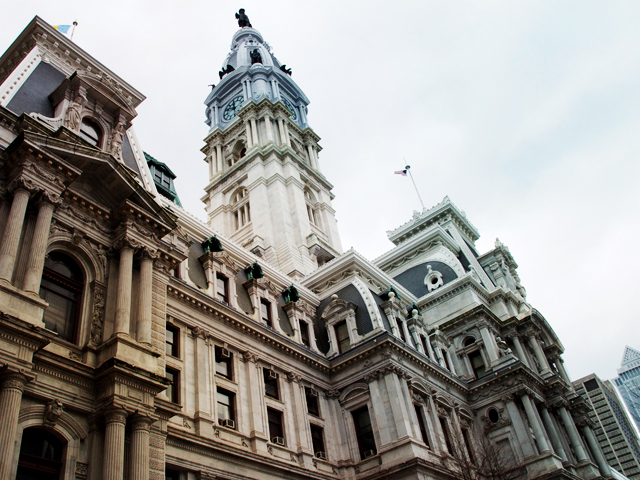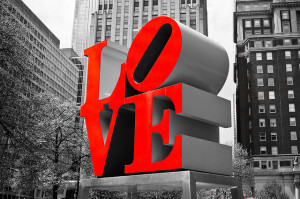
Philadelphia’s magnificent City Hall. Photo © Mike Myers, licensed Creative Commons Attribution.
More than 250 sculptures designed by Alexander Milne Calder adorn the magnificent City Hall. While you’re in the area, be sure to check out some of the other unique nearby sculptures.Across 15th Street on the west side of City Hall stands Claes Oldenburg’s 45-foot steel Clothespin. Sleek and modern, it offers a stark contrast to City Hall’s ornate design. Oldenburg has compared his clothespin to Constantin Brancusi’s The Kiss, and many agree that the shape is reminiscent of lovers holding one another. The Clothespin has also been viewed as a symbol of holding, or clipping, the old with the new in Philadelphia.
 LOVE sculpture in Center City Philadelphia.” width=”300″ height=”199″ class=”size-medium wp-image-14494″ /> The iconic landmark, Robert Indiana’s LOVE sculpture in Center City Philadelphia. Photo © Gene Tobia, licensed Creative Commons Attribution.
LOVE sculpture in Center City Philadelphia.” width=”300″ height=”199″ class=”size-medium wp-image-14494″ /> The iconic landmark, Robert Indiana’s LOVE sculpture in Center City Philadelphia. Photo © Gene Tobia, licensed Creative Commons Attribution.
At the intersection of 15th Street and John F. Kennedy Boulevard is John F. Kennedy Plaza, known to locals as Love Park because of the sculpture by Robert Indiana that stands proudly at its center. It is said that the crooked “O” in the bright-red letters that spell “love” is there to remind us that nothing— including love—is perfect.
Positioned at an angle so the Benjamin Franklin Parkway spreads out behind it with the Art Museum in the distance, the sculpture was installed for the city’s bicentennial in 1976 and quickly became an iconic image of the City of Brotherly Love.
Just north of City Hall across John F. Kennedy Boulevard, you can’t miss Jacques Lipchitz’s large Government of the People, one of several art installations in the plaza of the Municipal Services Building. The abstract bronze sculpture of hands and limbs gripping each other was built in the 1970s during the era of the polarizing mayor Frank Rizzo. Nearby stands a large replica of Rizzo himself, who fittingly has his back to Lipchitz’s statue. He purportedly cut off city funding for the statue that he hated and was quoted as saying, “It looks like some plasterer dropped a load of plaster.” Ah, the history of Philadelphia municipal politics.
Excerpted from the Third Edition of Moon Philadelphia .